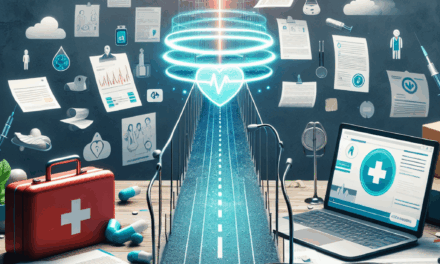Harnessing Cardiac Data through RPM to Tackle Clinical Challenges
In recent years, the healthcare landscape has undergone a significant transformation, driven by advancements in technology and a growing emphasis on patient-centered care. One of the most promising developments in this arena is the use of Remote Patient Monitoring (RPM) systems, particularly in the management of cardiac health. RPM leverages technology to collect and analyze cardiac data, enabling healthcare providers to address clinical challenges more effectively. This article delves into the multifaceted role of RPM in cardiac care, exploring its benefits, challenges, and future potential.
1. Understanding Remote Patient Monitoring (RPM)
Remote Patient Monitoring (RPM) refers to the use of digital technologies to monitor patients’ health data outside traditional clinical settings. This approach is particularly beneficial for patients with chronic conditions, such as heart disease, where continuous monitoring can lead to better outcomes.
1.1 Definition and Components of RPM
RPM encompasses a variety of technologies and methodologies designed to collect health data remotely. Key components include:
- Wearable Devices: These include smartwatches and fitness trackers that monitor heart rate, blood pressure, and other vital signs.
- Mobile Health Applications: Apps that allow patients to input their symptoms, medication adherence, and lifestyle choices.
- Telehealth Platforms: Systems that facilitate virtual consultations between patients and healthcare providers.
- Data Analytics Tools: Software that analyzes collected data to identify trends and potential health risks.
1.2 The Evolution of RPM in Cardiac Care
The integration of RPM in cardiac care has evolved significantly over the past decade. Initially, RPM was primarily used for post-operative monitoring. However, advancements in technology have expanded its applications to include:
- Chronic disease management
- Prevention of hospital readmissions
- Real-time monitoring of patients with arrhythmias
- Patient education and engagement
As a result, RPM has become an essential tool for cardiologists and primary care providers, enabling them to deliver more personalized and timely care.
2. Benefits of RPM in Cardiac Care
The implementation of RPM in cardiac care offers numerous benefits that can significantly improve patient outcomes and healthcare efficiency.
2.1 Enhanced Patient Engagement
One of the most significant advantages of RPM is its ability to enhance patient engagement. By providing patients with tools to monitor their health, RPM encourages them to take an active role in their care. This engagement can lead to:
- Improved adherence to treatment plans
- Increased awareness of personal health metrics
- Greater motivation to adopt healthier lifestyle choices
For instance, a study published in the Journal of Medical Internet Research found that patients using RPM tools reported higher satisfaction levels and were more likely to adhere to their prescribed treatment regimens.
2.2 Early Detection of Cardiac Events
RPM systems enable continuous monitoring of patients’ cardiac data, allowing for the early detection of potential health issues. This proactive approach can lead to:
- Timely interventions that prevent complications
- Reduced hospital admissions and emergency room visits
- Improved long-term health outcomes
For example, a case study involving a heart failure management program demonstrated that patients monitored through RPM experienced a 30% reduction in hospital readmissions compared to those receiving traditional care.
2.3 Cost-Effectiveness
Implementing RPM can lead to significant cost savings for both healthcare providers and patients. By reducing the need for in-person visits and hospitalizations, RPM can lower overall healthcare costs. Key factors contributing to cost-effectiveness include:
- Decreased travel expenses for patients
- Reduced administrative costs for healthcare providers
- Lower rates of hospital readmissions
A report from the American Heart Association estimated that RPM could save the healthcare system billions of dollars annually by improving chronic disease management and reducing unnecessary hospitalizations.
2.4 Improved Quality of Care
RPM enhances the quality of care by providing healthcare providers with real-time data to inform clinical decision-making. This data-driven approach allows for:
- Personalized treatment plans based on individual patient data
- Better management of comorbidities
- Enhanced communication between patients and providers
Research has shown that patients receiving RPM services report higher quality of care ratings, as they feel more connected to their healthcare team and more informed about their health status.
2.5 Accessibility and Convenience
RPM increases accessibility to healthcare services, particularly for patients in rural or underserved areas. By eliminating the need for frequent in-person visits, RPM allows patients to receive care from the comfort of their homes. This convenience can lead to:
- Increased access to specialists
- Greater flexibility in scheduling appointments
- Improved continuity of care
A survey conducted by the Pew Research Center found that 60% of patients preferred remote consultations over traditional in-person visits, citing convenience and time savings as primary reasons.
3. Challenges in Implementing RPM for Cardiac Care
Despite its numerous benefits, the implementation of RPM in cardiac care is not without challenges. Understanding these obstacles is crucial for successful integration into clinical practice.
3.1 Technological Barriers
The effectiveness of RPM relies heavily on technology, which can pose several challenges, including:
- Interoperability: Many RPM devices and software systems do not communicate effectively with existing electronic health record (EHR) systems, leading to fragmented data.
- Data Security: The collection and transmission of sensitive health data raise concerns about privacy and security breaches.
- Device Reliability: Inaccurate readings from wearable devices can lead to misdiagnosis or inappropriate treatment decisions.
Addressing these technological barriers requires collaboration between healthcare providers, technology developers, and regulatory bodies to establish standards and protocols for RPM systems.
3.2 Patient Compliance and Engagement
While RPM can enhance patient engagement, ensuring compliance with monitoring protocols remains a challenge. Factors influencing patient compliance include:
- Health Literacy: Patients with limited health literacy may struggle to understand how to use RPM devices effectively.
- Motivation: Some patients may lack the motivation to engage with RPM tools, particularly if they do not perceive immediate benefits.
- Technical Difficulties: Patients may encounter challenges in using technology, leading to frustration and disengagement.
To improve compliance, healthcare providers must offer comprehensive education and support to patients, ensuring they understand the importance of RPM in managing their cardiac health.
3.3 Regulatory and Reimbursement Issues
The regulatory landscape surrounding RPM is complex and can hinder its widespread adoption. Key challenges include:
- Reimbursement Policies: Many insurance providers have yet to establish clear reimbursement policies for RPM services, creating financial uncertainty for healthcare providers.
- Regulatory Compliance: Navigating the regulatory requirements for RPM devices can be daunting for healthcare organizations.
- Licensing Issues: Providers may face challenges related to licensing and credentialing when offering RPM services across state lines.
Advocacy for clearer regulations and reimbursement policies is essential to facilitate the growth of RPM in cardiac care.
3.4 Integration into Clinical Workflows
Integrating RPM into existing clinical workflows can be challenging for healthcare organizations. Key considerations include:
- Training Staff: Healthcare providers must be trained to use RPM tools effectively and interpret the data generated.
- Workflow Adjustments: Organizations may need to adjust their workflows to accommodate the integration of RPM, which can be resource-intensive.
- Data Management: Efficiently managing and analyzing the large volumes of data generated by RPM systems can strain existing resources.
Successful integration requires careful planning and collaboration among clinical teams to ensure that RPM enhances rather than disrupts patient care.
3.5 Ethical Considerations
The use of RPM raises several ethical considerations that must be addressed, including:
- Informed Consent: Patients must be adequately informed about how their data will be used and the potential risks associated with RPM.
- Equity of Access: Ensuring that all patients have access to RPM technologies is crucial to avoid exacerbating health disparities.
- Data Ownership: Questions surrounding who owns the data collected through RPM systems must be clarified to protect patient rights.
Healthcare organizations must prioritize ethical considerations in their RPM initiatives to build trust with patients and ensure equitable access to care.
4. Case Studies: Successful Implementation of RPM in Cardiac Care
Examining real-world examples of RPM implementation in cardiac care can provide valuable insights into best practices and potential outcomes.
4.1 The Heart Failure Management Program at Mount Sinai Health System
Mount Sinai Health System in New York City implemented an RPM program for heart failure patients, utilizing wearable devices to monitor vital signs and symptoms. Key components of the program included:
- Daily monitoring of weight, heart rate, and blood pressure
- Real-time alerts for healthcare providers when patients exhibited concerning trends
- Regular virtual check-ins with care teams
The results were promising, with a reported 40% reduction in hospital readmissions among participants. Patients expressed high satisfaction levels, citing the convenience and support provided by the program.
4.2 The Telemonitoring Program at the University of Michigan
The University of Michigan launched a telemonitoring program for patients with atrial fibrillation, focusing on remote monitoring of heart rhythm and medication adherence. Key features included:
- Use of mobile health applications to track symptoms and medication intake
- Regular communication with healthcare providers through telehealth consultations
- Patient education on managing atrial fibrillation
The program demonstrated a significant improvement in patient outcomes, with a 25% reduction in emergency department visits and increased patient knowledge about their condition.
4.3 The RPM Initiative at the Cleveland Clinic
The Cleveland Clinic implemented an RPM initiative for patients with chronic obstructive pulmonary disease (COPD) and heart failure. The program utilized a combination of wearable devices and telehealth consultations. Key outcomes included:
- Improved patient adherence to treatment plans
- Enhanced communication between patients and care teams
- Reduction in hospital admissions by 30%
This initiative highlighted the potential of RPM to improve outcomes not only for cardiac patients but also for those with comorbid conditions.
4.4 The RPM Program at Geisinger Health System
Geisinger Health System in Pennsylvania developed an RPM program for patients with heart failure, focusing on remote monitoring of vital signs and symptom management. Key components included:
- Daily check-ins via mobile applications
- Real-time alerts for healthcare providers
- Patient education on recognizing early signs of deterioration
The program resulted in a 50% reduction in hospital readmissions and improved patient satisfaction scores, demonstrating the effectiveness of RPM in managing heart failure.
4.5 The RPM Initiative at Partners HealthCare
Partners HealthCare in Massachusetts launched an RPM initiative for patients with coronary artery disease, utilizing wearable devices to monitor heart rate and activity levels. Key outcomes included:
- Increased patient engagement and adherence to lifestyle modifications
- Reduction in emergency department visits by 20%
- Improved communication between patients and care teams
This initiative underscored the importance of RPM in promoting preventive care and empowering patients to take control of their health.
5. The Future of RPM in Cardiac Care
The future of RPM in cardiac care is promising, with ongoing advancements in technology and a growing recognition of its potential benefits. Several trends are likely to shape the future landscape of RPM.
5.1 Integration of Artificial Intelligence (AI)
The integration of artificial intelligence (AI) into RPM systems has the potential to revolutionize cardiac care. AI can enhance data analysis, enabling healthcare providers to:
- Identify patterns and trends in patient data more effectively
- Predict potential health issues before they arise
- Personalize treatment plans based on individual patient data
For example, AI algorithms can analyze data from wearable devices to detect irregular heart rhythms, alerting healthcare providers to intervene promptly.
5.2 Expansion of Telehealth Services
The COVID-19 pandemic accelerated the adoption of telehealth services, and this trend is expected to continue. As telehealth becomes more integrated with RPM, patients will benefit from:
- Increased access to specialists
- Greater convenience in managing their health
- Enhanced continuity of care through virtual consultations
This expansion will likely lead to improved patient outcomes and satisfaction as healthcare becomes more accessible and patient-centered.
5.3 Development of Advanced Wearable Technologies
Advancements in wearable technology will continue to play a crucial role in the evolution of RPM. Future developments may include:
- More accurate and reliable sensors for monitoring vital signs
- Integration of additional health metrics, such as glucose levels and oxygen saturation
- Improved battery life and user-friendly interfaces
These advancements will enhance the effectiveness of RPM systems and empower patients to take control of their cardiac health.
5.4 Focus on Health Equity
As RPM continues to grow, addressing health equity will be paramount. Efforts to ensure that all patients have access to RPM technologies may include:
- Subsidizing costs for low-income patients
- Providing education and support for underserved populations
- Developing culturally sensitive RPM programs
By prioritizing health equity, healthcare organizations can ensure that the benefits of RPM are accessible to all patients, regardless of socioeconomic status.
5.5 Regulatory Advancements
As RPM becomes more prevalent, regulatory bodies are likely to establish clearer guidelines and reimbursement policies. This may include:
- Streamlining the approval process for RPM devices
- Establishing reimbursement codes for RPM services
- Creating standards for data security and privacy
These advancements will facilitate the growth of RPM in cardiac care and encourage healthcare providers to adopt these innovative technologies.
Conclusion
Harnessing cardiac data through Remote Patient Monitoring (RPM) presents a transformative opportunity to tackle clinical challenges in cardiac care. The benefits of RPM, including enhanced patient engagement, early detection of cardiac events, cost-effectiveness, improved quality of care, and increased accessibility, underscore its potential to revolutionize how healthcare is delivered.
However, challenges such as technological barriers, patient compliance, regulatory issues, integration into clinical workflows, and ethical considerations must be addressed to fully realize the potential of RPM. Successful case studies from leading healthcare organizations demonstrate the effectiveness of RPM in improving patient outcomes and satisfaction.
The future of RPM in cardiac care is bright, with advancements in artificial intelligence, telehealth services, wearable technologies, health equity initiatives, and regulatory advancements poised to shape its evolution. By embracing these innovations and addressing existing challenges, healthcare providers can harness the power of cardiac data through RPM to deliver more personalized, effective, and equitable care to patients.
As we move forward, it is essential for healthcare organizations, technology developers, and policymakers to collaborate in creating a robust framework for RPM that prioritizes patient needs and enhances the overall quality of care. The journey toward a more connected and patient-centered healthcare system is underway, and RPM will undoubtedly play a pivotal role in shaping its future.





